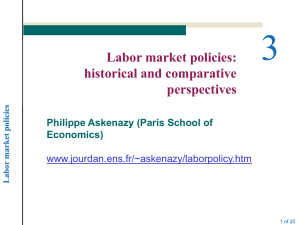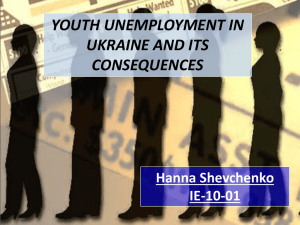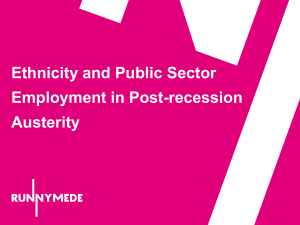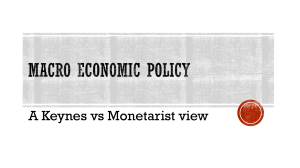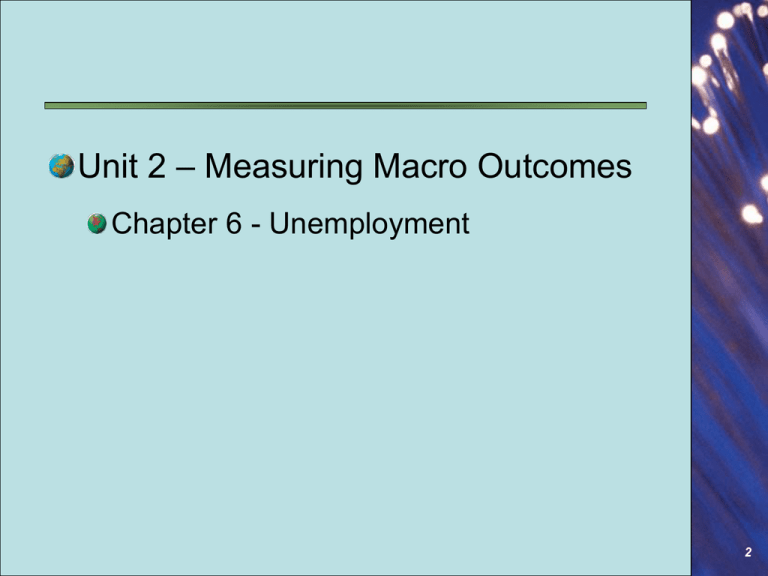
Unit 2 – Measuring Macro Outcomes
Chapter 6 - Unemployment
2
Chapter 6 - Unemployment
1.
2.
3.
4.
5.
The Labor Force.
Measuring Unemployment.
The Human Costs of Unemployment.
Defining FULL Employment.
The Historical Record.
3
1 – The Labor Force
4
The Labor Force
The labor force:
≥ age sixteen,
working for pay, or …
actively seeking paid employment.
Not in the labor force:
People who are not employed, and…
not actively seeking work.
“nonparticipants.”
LO1
5
The Labor Force
Labor force participation rate =
Labor force
population
The percentage of the population working
or seeking employment.
Example: 151 billion
300 billion
LO1
= 50.3%
6
The Labor Force, 2006
(pg. 107)
LO1
7
A Growing Labor Force
(pg. 108, figure 6.2)
8
Growth of Production Possibilities
Production is limited by two factors:
The availability of factors of production.
Technological know-how.
A growing labor force creates longrun economic growth.
9
Labor Force Growth
Investment Goods (units per year)
(pg. 108, figure 6.3)
C
H
A
F
O
Labor-force growth
increases
production
possibilities
G
B
D
Consumption Goods (units per year)
10
Institutional Constraints
Physical production possibilities:
Dictated by available resources and
technology only.
Institutional production possibilities:
dependent on available resources and
technology, and …
on how we choose to restrict their use.
Ex: child labor, strip mining, pollution
restrictions, land preservation.
11
The Institutional Production
Possibilities Curve
Always falls
within/up-to the
physical production
possibilities curve.
Determined by the
restrictions we
impose.
12
Unemployment
Unemployment:
the inability of labor-force participants
to find jobs.
LO1
14
Okun’s Law: Lost Output
Okun’s Law:
asserts that 1% more unemployment
results in 2 percent less output.
15
2 – Measuring
Unemployment
17
Measuring Unemployment
The U.S. Census Bureau surveys
about 60,000 households a month.
A person is considered unemployed
if he or she is:
not employed, and …
is actively seeking a job.
LO1
18
The Unemployment Rate
Unemployment rate:
the proportion of the labor force that is
unemployed.
number of unemployed people
Unemployment rate =
labor force
10,900,000
7.2% =
151,000,000
http://www.youtube.com/watch?v=u0-oinyjsk0&feature=related
http://www.youtube.com/watch?v=daFb3J-cwLg&feature=related
LO1
19
Unemployment Isn’t Experienced
Equally by Race or Sex
(pg. 110, figure 6.4)
21
Unemployment Isn’t Experienced
Equally by Education
(pg. 110, figure 6.4)
22
Europe’s Unemployment Woes
Unemployment levels in Europe are
much higher than those of the U.S.
Analysts blame:
sluggish economic growth, and …
high unemployment benefits.
23
Europe’s Unemployment Woes
(pg. 113, World View)
24
Duration of Unemployment
When the economy is growing:
unemployment rates decline, and …
the average duration of unemployment
declines.
25
Duration of Unemployment:
(pg. 110, table 6.1)
Duration
Percent of Unemployed
Less than 5 weeks
31.7
5 to 14 weeks
15 to 26 weeks
27 to 51 weeks
29.8
16.4
22.1
26
Reasons for Unemployment
There are several categories of
reasons for unemployment:
Job leavers
Job losers
New entrants
Reentrants
The reason for unemployment can
affect the length of unemployment.
27
Reasons for Unemployment
(pg. 111, figure 6.5)
Job leavers 12%
New entrants 9%
Reentrants 32%
Job losers 47%
28
Discouraged Workers
Discouraged worker:
an individual who is :
not actively seeking employment, but …
would look for or accept a job if one were
available.
not counted as unemployed because
they have given-up looking for a job.
LO1
29
Underemployment
30
Underemployment
Underemployment:
exists when people seeking full-time
paid employment work:
only part time, or …
are employed at jobs below their
capability.
Underemployed workers represent
labor resources that are not being fully
utilized.
LO1
31
The Phantom Unemployed
Some of the people who are counted
as unemployed probably should not
be.
Public policy may encourage people
to report that they are actively seeking
work when they really don’t want a
job.
-Vandaley Industries.
LO1
32
3. The Human Costs
Of
Unemployment
33
The Human Costs
The most obvious impact of
unemployment is loss of income.
Unemployment can be financially
devastating.
34
The Human Costs
Less immediately visible impacts:
Social:
Crime, divorce, domestic violence, social
withdrawal, etc.
Psychological:
Stress, anxiety, depression, confidence loss,
suicide rates, etc.
Physical health:
1 yr. of unemployment = 5 years of life span?
35
The Human Costs
(pg. 114, In The News)
36
4. Defining
FULL Employment.
37
Types of Unemployment
There are four main types of
unemployment:
Seasonal
Frictional
Structural
Cyclical
LO3
39
Seasonal Unemployment
Seasonal unemployment:
unemployment due to seasonal
changes in employment or labor
supply.
The Labor Department reports
seasonally adjusted unemployment
rates for every month.
LO2
40
Frictional Unemployment
Frictional unemployment:
brief periods of unemployment
experienced by people who are:
moving between jobs, or …
moving into the labor market.
LO2
41
Frictional Unemployment
Frictional unemployment differs
from other unemployment in three
ways:
There is adequate demand for the
labor of the frictionally unemployed.
The frictionally unemployed have the
skills required for existing jobs.
The job-search period will be relatively
short.
LO2
42
Structural Unemployment
Structural unemployment:
caused by a mismatch between:
the skills (or location) of job seekers, and …
the requirements (or location) of available
jobs.
“Square pegs in a world of round holes.”
A very serious form of unemployment.
LO2
43
Cyclical Unemployment
Cyclical unemployment:
unemployment that occurs due to a
downturn in the business cycle
(recession).
i.e., due to a lack of job vacancies –
an inadequate level of aggregate demand.
LO2
44
Cyclical Unemployment
45
The Unemployment Record
(pg. 116, figure 6.6)
46
Slow Growth
To avoid cyclical unemployment,
the economy must grow at least as
fast as the labor force.
LO2
47
The Full-Employment Goal
Employment Act of 1946:
Congress committed the federal government
to pursue a maximum employment goal.
Congress didn’t specify what the actual
rate of unemployment should be.
So, …
why not set the goal at Zero
unemployment???
LO3
48
Inflationary Pressures
Rising prices are a signal that
employment is nearing capacity.
Inflation can derail a growing economy.
So…
LO3
49
Full-Employment
“Full” employment :
zero unemployment.
The lowest rate of unemployment
compatible with price stability.
Whatever that figure may be at any given
time, it changes with changes in the
structure of the economy.
LO3
50
Changes in Structural Unemployment
During the 1960s, the Council of Economic Advisors
placed full employment at 4% unemployment.
During 1970s and early 1980s structural barriers to
full employment had gotten worse.
More youth and women.
Liberal transfer payments.
Structural changes in demand.
In 1983, the Reagan administration concluded that
the inflation-threshold unemployment rate was
between 6 and 7 percent.
LO3
51
Declining Structural Pressures
The structural barriers that intensified
inflationary pressures in the 1970s and
early 1980s receded in the 1990s.
This made it easier to lower
unemployment rates without increasing
inflation.
LO3
52
The “Natural” Rate of
Unemployment
- A different view:
The natural rate of unemployment:
the long-term rate of unemployment
determined by frictional and structural
forces in labor and product markets.
the economy will gravitate to the natural
rate despite short-term price/employment
fluctuations.
LO3
53
Congressional Targets
The Full Employment and
Balanced Growth Act of 1978
(Humphrey-Hawkins Act):
set 4% unemployment rate,
and 3% inflation as a national goal.
LO3
54
5. The Historical
Record
55
The Historical Record
As many as one-fourth of the labor
force was unemployed during the
Great Depression.
During World War II, the civilian
unemployment rate fell to 1.2
percent.
56
The Historical Record
The unemployment rate has
fluctuated from a low of 2.8 percent
during the Korean War (1953) to a
high of 10.8 percent during the 198182 recession.
57
The Historical Record
From 1982 to 1989, unemployment
fell, but shot up again in the 1990-91
recession.
Unemployment fell steadily during the
last half of the 1990s.
The unemployment rate rose sharply
in late 2001 but fell again through
2005.
The “Great Recession” began in 2007
58
The Historical Record
59
The Historical Record
(pg. 116, figure 6.6)
60
Unemployment
End of Chapter 6
McGraw-Hill/Irwin
©2008 The McGraw-Hill Companies,
All Rights Reserved




